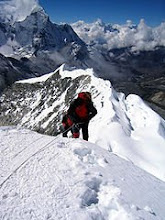| Reinhold Messner | |
 Reinhold Messner in May 2004 | |
| Born | September 17, 1944 Brixen, Italy |
|---|---|
| Occupation | Mountaineer |
| Website www.reinhold-messner.de | |
Reinhold Messner
Biography
Born in Brixen, Italy, and a native speaker of German and fluent in Italian,[1] he grew up in Villnöß and spent his early years climbing in the Alps and fell in love with the Dolomites. His father, Josef Messner, was a teacher. He was also very strict and sometimes severe with Reinhold. Josef led Reinhold to his first summit at the age of five. Reinhold had eight brothers and one sister: he later climbed with his brother Günther and made Arctic crossings with his brother Hubert.
When Reinhold was 13, he began climbing with his brother Günther, age 11. By the time Reinhold and Günther were in their early twenties, they were among Europe's best climbers.[2]
Since the sixties, and inspired by Hermann Buhl, he was one of the first and most enthusiastic supporters of alpine style mountaineering in the Himalayas, which consisted of climbing with very light equipment and a minimum of external help. Messner considered the usual expedition style ("siege tactics") disrespectful towards nature and mountains.
His first major Himalayan climb in 1970, the unclimbed Rupal face of Nanga Parbat, turned out to be a tragic success. Both he and his brother Günther Messner reached the summit, but Günther died two days later on the descent of the Diamir face. Reinhold lost six toes, which had become badly frostbitten during the climb and required amputation.[2] Reinhold has been severely criticized for persisting on this climb with an insufficiently experienced Günther.[3]
While Messner and Peter Habeler were noted for fast ascents in the Alps of the Eiger North Wall, standard route (10 hours) and Les Droites (8 hours), his 1975 Gasherbrum I first ascent of a new route took 3 days. This was unheard of at the time. And similarly his second solo Everest ascent was also done in a short time.
In the 1970s, Messner championed the cause for ascending Mount Everest without supplementary oxygen, saying that he would do it "by fair means" or not at all.[4] In 1978, he reached the summit of Everest with Habeler.[4] This was the first time anyone had been that high without bottled oxygen and Messner and Habeler proved what most doctors, specialists, and mountaineers thought impossible. It changed mountaineering forever. He repeated the feat, without Habeler, from the Tibetan side in 1980, during the monsoon season. This was Everest's first solo summit.
In 1978, he made a solo ascent of the technically difficult Diamir face of Nanga Parbat. In 1986, Messner became the first to complete all fourteen eight-thousanders (peaks over 8,000 metres above sea level).[5] Messner has crossed Antarctica on skis with Arved Fuchs. He authored over 60 books about his experiences, a quarter of which are translated into English and other languages. He was featured in the 1984 film The Dark Glow of the Mountains by Werner Herzog.
Messner today carries on a diversified business related to his mountaineering skills. From 1999 to 2004, he held political office as a Member of the European Parliament for the Italian Green Party (Federazione dei Verdi). He was also among the founders of Mountain Wilderness, an international NGO dedicated to the protection of mountains worldwide.
In 2004 he crossed 2000 kilometres through the Gobi desert. He has now mainly devoted himself to the Messner Mountain Museum, a complex of museums, about several mountain-related themes, of which he is the founder.
[edit] The fourteen 8,000+ peaks
- 1970: Nanga Parbat (8125 m)
- 1972: Manaslu (8156 m)
- 1975: Gasherbrum I (Hidden Peak) (8068 m)
- 1977: Dhaulagiri (8167 m)
- 1978: Mount Everest (8848 m) (First ascent without supplementary oxygen), Nanga Parbat (8125 m) (First solo ascent of an 8000er from basecamp)
- 1979: K2 (8611 m)
- 1980: Mount Everest (8848 m) (First person to ascend alone and without supplementary oxygen - during the monsoon)
- 1981: Shisha Pangma (8012 m)
- 1982: Kangchenjunga (8598 m), Gasherbrum II (8035 m), Broad Peak (8048 m), Cho Oyu (8201 m - summit attempt during winter failed)
- 1983: Cho Oyu (8201 m)
- 1984: Gasherbrum I (8068 m) and Gasherbrum II (8035 m) at one time without returning to basecamp
- 1985: Annapurna (8091 m), Dhaulagiri (8167 m)
- 1986: Makalu (8485 m), Lhotse (8516 m)










